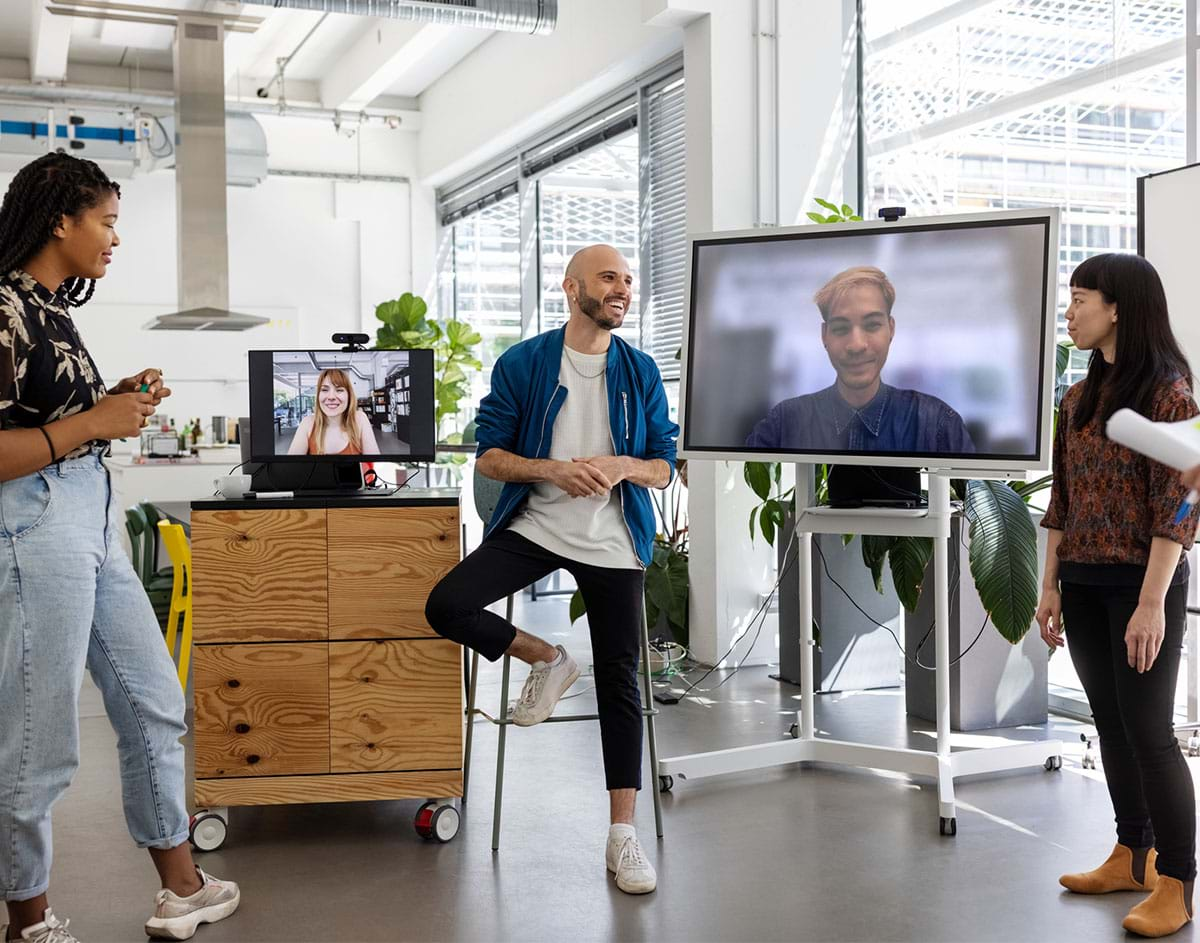Reconceiving the Missing Layers of the Internet for a More Just Future
The internet is among the most complex systems ever built, with a sprawling digital infrastructure of millions of interconnected devices and networks that, together, enable us to connect and communicate with one another around the world in real time. The web, though often considered interchangeable as a term, is different: it is a collection of billions of pieces of information accessed by people on the internet. Globally, open protocols such as HTTP serve as a common dialect used by devices and systems to enable internet users to access and supply information on the web.
In the early days of the internet, cross-sector collaboration by academia, the public sector, and technology companies led to the development of these open protocols, which served as the building blocks of the modern web.
These protocols still govern data flow and work across the internet, and have set a framework in which the primary ways of interacting with the open web—loading pages, transferring content, accessing web sites—are not owned by any one entity. This was intentional: The internet’s founders recognized the critical need for the public to be involved in the system’s considerations and decisions, and they took deliberate steps to embed civil society into the internet’s processes of governance.
In the 1979 paper Computers and Government, internet founders predicted that establishing protocols on the internet would be necessary to build user trust, including ones that verified identity and facilitated commerce and communications. They saw that open protocols for routing internet communications would not be enough to enable global collaboration on the web—further layers of functionality would be needed, including ways to authenticate new users and ways to securely share data. They worried that, if not established openly, these key layers would be developed and controlled by proprietary platforms, leading to a lack of competition, trust, and democratic stability.
 Getty
Getty Getty
GettyOver four decades later, these pre-digital predictions have in many ways been borne out. Daily, we witness privacy violations, concentrations of power, and digital divides in societies the world over. These are drivers of social and economic inequality that can be tracked largely to a lack of these critical open protocols. How can we reconceive the missing layers of the internet with open protocols that establish a people-centric digital ecosystem?
Last year, the Ford Foundation, New America’s Digital Impact and Governance Initiative, and Microsoft began seeding a working group to explore an answer, based on the belief that engagement across philanthropy, civil society, and the private sector could contribute to enabling a positive digital future. The initial months of the working group revealed broad agreement that while digital technology has been a crucial tool for societal progress, it also has the potential to be further misused and abused.
The collaboration began by focusing on an area of shared interest: the core principle that the digital infrastructure we rely on to connect, execute transactions, and share information should both advance innovation and protect fundamental values. Soon, we began to reach out to individuals at other leading organizations across sectors to engage in structured feedback opportunities and learning roundtables that help grow our collaboration. These included experts from Article 19, BlueSky, New Public and Civic Signals, Co-Develop, Digital Public, Global Partners Digital, Twitter, University of Massachusetts Amherst Initiative for Digital Public Infrastructure, Strauss Center at the University of Texas, R Street Institute, and Stanford Global Digital Policy Incubator, among others.
Even though these groups operate in different sectors, all agree that technology must be developed in accordance with key fundamental values including strengthening democracy and human rights, advancing equity, and fostering shared prosperity. They also recognize that, much like the development of the early internet, cross-sector collaboration is critical to harnessing technology for the common good. Sustaining the internet is also not a single-sector endeavor, nor are its challenges solvable by a single business, government, technology, organization, or corrective measure.
With these points in mind, the aim of this Missing Layers collaboration has been to develop an actionable vision for digital technology to counter present harms and chart a path towards a jointly designed and shared digital infrastructure that can enable a democratic technology ecosystem. This work builds on years of excellent and insightful contributions of countless technologists, activists, and advocates who have surfaced these and related issues.
While regulation is critical to meeting these ends, governments acting alone is insufficient. The aim of this collaboration is to envision a model that complements and inspires government regulation toward a democratically built and sustained technology ecosystem. Our working group is exploring a way to build such a model by expanding existing structures for internet governance, based on open participation, competitive innovation, and meaningful accountability. This requires a multi-pronged approach that combines effective regulation with the further development of open protocols and standards, with the ultimate goals being realistic pathways towards adoption, accountable governance, and the protection of individual and collective rights.
Unlocking the potential of people-centric open protocols
As described above, existing protocols such as HTTP, SMTP, and TCP/IP are the infrastructure used to transfer information over the internet and enable the global exchange of ideas and commerce. As a complement to regulatory reform, expanding the scope of these open protocols and adaptive governance mechanisms can address social and economic inequality by supporting greater security, transparency, competition, and accountability in digital solutions, as well as lower switching costs and improving access to the internet. These approaches also better enable interoperability, which improves the way different systems, devices or applications communicate with one another, making them more compatible without requiring significant effort from the end user.
 Getty
GettyOver the past several months, the working group identified four areas where we think further development of protocols and governance mechanisms could serve as building blocks for better outcomes for various users—including individuals, private sector companies, and public sector leaders—to shape a healthier, more inclusive, and sustainable digital ecosystem.
1. Trust in Data Sharing
The access to privacy-preserving control over information and increased transparency around how personal data is collected, paired with the ability to securely exchange data insights across organizations
- Individuals: Regain control over how personal data is used and exchanged
- Private Sector: Gains access to data insights across organizations
- Public Sector: Increases data-sharing across agencies to improve public service provision
2. Open Communication
The right to freely express, communicate, and associate with others in a stable digital sphere free of disruptions (such as shutdowns) while respecting fundamental rights and rules of law
- Individuals: Move freely between services and reduce friction in switching providers
- Private Sector: Increases competition and opportunities to create new digital public spaces
- Public Sector: Protects the right to openly express, communicate, and associate with others; increases public dialogue
3. Identity Control and Verification
The ability to own, control, and transfer a reliable and secure digital identity or credential for verification and access
- Individuals: Lower costs, can validate identity across organizations to easily access services
- Private Sector: Easily verifies the identities of customers without relying on intermediaries
- Public Sector: Improves access and service delivery of benefits, reduces fraud
4. Exchange of Payment
The ability to conduct secure, accountable, convenient, and inexpensive transactions, (including peer-to-peer) across platforms
- Individuals: Easily access payment instruments at low cost and with less overhead
- Private Sector: Lowers cost of digital transactions and direct relationships to customers
- Public Sector: Distributes public services and benefits securely, seamlessly, and with greater accountability
Building the Future: What We’ve Done, What We’ll Do
Drafting a vision for more open protocols is a complex process. It intersects with everything from cybersecurity to technical specifications and interoperability concerns to cross-border communication infrastructure and corporate governance. Meeting this complexity requires diverse perspectives and experiences across sectors. We are continuing to expand our circle of collaborators and welcome others who can provide insight as we imagine, design, and build these plans. In this, we have taken an example from the early internet, which was designed as an open network of networks, funded and championed by the public sector, supported by academic institutions and the private sector, and governed by multiple stakeholders.
As our first phase of collaboration came to a close, the working group hosted a community lab at RightsCon 2022 to solicit feedback from the public on our four identified missing open protocols. The lab was interactive, with participants discussing, developing, and debating the challenges and solutions we posed. Participants provided useful feedback on the proposed protocols, with special attention paid to identity verification and digital payments.
Looking forward, we plan to continue hosting listening and learning sessions to test our logic and assumptions, identify additional stakeholders to address gaps in our analyses, solicit information about past and current models we can build from, and anticipate challenges ahead. In particular, we are developing a roadmap of opportunities and preparing next steps that will bring us closer to realizing the true potential of people-centric internet protocols, with the aim of publishing a vision for public comment in 2023.
As the Missing Layers Initiative continues its work, we invite other public interest technologists, researchers, advocates, and innovators to provide creative and practical ideas on what these missing protocols could look like and how to implement them in ways that advance social and economic justice. If you have resources or ideas to share with us, or would simply like more information, please connect with us here.
Additional contributors to this post include: Allison Price, Divya Siddarth, Jordan Usdan, Sarah Forland, and Summer Boucher-Robinson.

